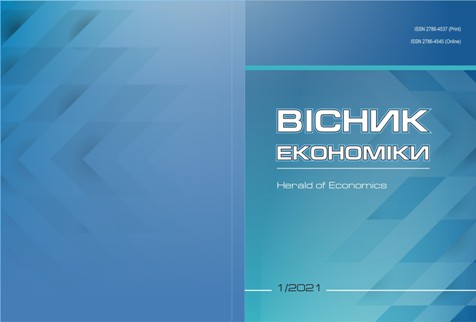Bioenergy assets in the global climate scenario: multilevel model of functions
DOI:
https://doi.org/10.35774/visnyk2023.03.131Keywords:
accounting, bioenergy, climate, ecology, biomass, innovationsAbstract
Introduction. Dynamic European integration processes and russia’s military invasion of Ukraine dictate new conditions for the development of the national energy system. The use of renewable energy sources can be a key direction in the implementation of energy independence and the decarbonization strategy. However, the lack of a standardized accounting system for bioenergy assets, as one of the renewable energy sources, makes it impossible to develop Ukraine’s energy policy in this direction.
The aim of the study. The purpose of the article is to justify the importance of recognizing bioenergy assets as an object of accounting due to its positive impact on the global climate scenario and creating a multi-level model of functions of their use.
Methods. The methodological basis of the study is the dialectical method of cognition using a systemic approach. Induction and analysis contributed to the identification of a significant impact of the lack of accounting methodology of bioenergy assets on the global ecological system in general, which strengthened the need for research in this direction. Economic and mathematical, graphic and historical methods were used to develop and illustrate the growth of CO2 emissions into the atmosphere over the past 120 years. To create a multi-level model of the functions of bioenergy assets, graphic and factor analysis of the impact on different levels of the economy was used.
The results. The article substantiates that bioenergy assets are a factor of positive changes in the global climate scenario in terms of decarbonization of the atmosphere. The functions of bioenergy assets were studied through the prism of the levels of the economy, and a multilevel model of the functions of bioenergy assets was created in order to assess their significance for the global economic and ecological space. The advantages of displaying information about bioenergy assets in the company’s accounting and integrated reporting are determined and the risks of not displaying it are highlighted for the assessment of the consequences of the introduction of an innovative accounting object.
Prospects for further research. Further research is needed in identifying the criteria for recognition of bioenergy assets as an object of accounting and to form a methodology for their display in the accounting and analytical system of agrarian enterprises.
References
Ukraine: Commission presents plans for the Union’s immediate response to address Ukraine’s financing gap and the longer-term reconstruction. Press and information team of the Delegation to UKRAINE. Brussels. 18.05.2022. Retrieved from https://ireland.representation.ec.europa.eu/news-and-events/news/ukraine- european-commission-presents-plans-unions-immediate-response-address- ukraines-financing-gap-2022-05-18_en [in English].
Natsionalnyi plan dii z energoefektyvnosti na perion do 2030 roku: Rozporiadzennia Kabinetu Ministriv Ukrainy vid 29.12.2021. № 1803-р. [National Action Plan for Renewable Energy for the Period to 2030: Order of the Cabinet of Ministers of Ukraine from 29.12.2021. № 1803-р.]. Retrieved from https://zakon.rada.gov.ua/ laws/show/1803-2021-%D1%80#Text [in Ukrainian].
Pro shvalennia Energetychnoi strategii Ukrainy na period do 2050 roku: Rozporiadzennia Kabinetu Ministriv Ukrainy vid 21.04.2023. № 373-р [On the approval of the Energy Strategy of Ukraine for the period until 2050: Order of the Cabinet of Ministers of Ukraine from 21.04.2023. № 373-р]. Retrieved from https:// zakon.rada.gov.ua/laws/show/373-2023-%D1%80#Text [in Ukrainian].
International energy agency. News. Global CO2 emissions rebounded to their highest level in history in 2021. Retrieved from https://www.iea.org/news/global- co2-emissions-rebounded-to-their-highest-level-in-history-in-2021 [in English].
Ministerstvo finansiv Ukrainy. Valovyi vnutrishnii product Ukrainy v 2021 rotsi. [Ministry of Finance (Ukraine). Gross domestic product in Ukraine 2021]. Retrieved from https://index.minfin.com.ua/ua/economy/gdp/2021/ [in Ukrainian].
Walter V. Reid, Mariam K. Ali, Christopher B. Field. (2019). The future of bioenergy. Global Change Biology. Vol. 26, Issue 1. P. 274-286. Retrieved from https://doi. org/10.1111/gcb.14883 [in English].
Femeena, P.V., Mehan, S., Cibin, R. (2019). Environmental impacts of bioenergy crop production and benefits of multifunctional bioenergy systems. In: Bioenergy with Carbon Capture and Storage. Academic Press, pp. 195–217. Retrieved from https://doi.org/10.1016/B978-0-12-816229-3.00010-7 [in English].
Avagyan, A. B. (2021). Theory of bioenergy accumulation and transformation: application to evolution, energy, sustainable development, climate change, manufacturing, agriculture, military activity and pandemic challenges. Athens J. Sci. 2021. 8 (1). P. 57-80. Retrieved from https://www.athensjournals.gr/sciences/2021- 8-1-4-Avagyan.pdf [in English].
Rather Dr-Rauoof, Wani Ab Waheed, Mumtaz, Sumaya, Padder, Shahid, Khan Afzal, Almohana Abdulaziz, Almojil Sattam, Alam Shah Saud, Baba Tawseef. (2022). Bioenergy: a foundation to environmental sustainability in a changing global climate scenario. Journal of King Saud University - Science. Vol. 34, Issue 1. Retrieved from https://doi.org/10.1016/j.jksus.2021.101734 [in English].
Borysiak O., Brych V. (2022). Post-COVID-19 Revitalization and Prospects for Climate Neutral Energy Security Technologies. Probl. Ekorozw. 17. P. 31-38. Retrieved from DOI: 10.35784/pe.2022.2.04 [in English].
Zhuk, V. M. (2010). Fiziokratychna pobudova obliku silskohospodsrskoi diyalnosti [Physiocratic basis for building accounting for agricultural activities]. Ahroinkom, (7–9), 57–62 [in Ukrainian].
Honcharuk, I. V., Ishchenko, Ya. P., Stryhun, I. V. (2017). Organizatsiini aspekty oblikovogo zabezpechennia upravlinnia v integrovanyh naukovo-vyrobnychyh strukturah (na prykladi Instytutu bioenergetychnyh kultur I tsukrovyh buriakiv Natsionalnoi akademii agrarnyh nauk Ukrainy) [Organizational aspects of management accounting in integrated research and production structures (on the example of the Institute of Bioenergy Crops and Sugar Beet of the National Academy of Agrarian Sciences of Ukraine)]. Ekonomika. Finansy. Menedzhment: aktualni pytannia nauky i praktyky – Economics. Finance. Management: Topical Issues of Science and Practice, (9), 33-45 [in Ukrainian].
Hutsalenko, L. V., Fabiianska, V. Yu. (2013). Organizatsiia obliku ta kontroliu biologichnogo palyva [Organization of accounting and control of biofuel production]. Vinnytsia: Edelveis, K. 259 p. [in Ukrainian].
Derii, V. (2010). Oblik i control za vytratamy na vyrobnytstvo biopalyva [Accounting and control over the cost of biofuel production]. Ekonomichnyi analiz – Economic analysis, (6), 414-419 [in Ukrainian].
Rudenko M. Energiia progresu. Vybrani pratsi z ekonomii, filosofii ta kosmologii [The energy of progress. Selected works on economics, philosophy and cosmology]. K: Klio Publishing House. 2015. 680 p. [in Ukrainian].
Sudyn, Y. (2015). Innovative methods of evaluating goodwill in increasing the competitiveness of the company. Przedsiębiorstwo i Region, 7 (1), 105-112 [in English].
Global climate change. The Effects of Climate Change. Retrieved from https:// climate.nasa.gov/effects/ [in English].



